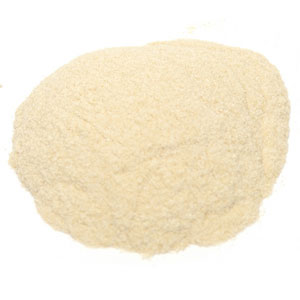Stabiliser (food)
Stabilisers in food are substances that are used to maintain the physical characteristics of food products. They help to ensure that the food's texture, moisture content, and structure remain consistent over time. Stabilisers can be derived from a variety of sources, including plants, animals, and synthetic compounds. They play a crucial role in the food manufacturing process, particularly in products such as ice cream, yogurt, jelly, and sauces, where a stable emulsion or consistency is desired.
Types of Stabilisers[edit | edit source]
There are several types of stabilisers, each serving a specific function in food preservation and texture enhancement. Common types include:
- Gelatin: Derived from animal collagen, gelatin is used to gel, thicken, and stabilize desserts like jellies and custards.
- Pectin: A plant-based stabiliser found in fruits, pectin is used to thicken jams, jellies, and marmalades.
- Guar gum: Extracted from guar beans, this stabiliser is used to improve texture and stability in dairy products, dressings, and gluten-free baked goods.
- Xanthan gum: A fermentation product, xanthan gum is used in a wide range of foods to enhance texture, especially in gluten-free baking.
- Agar: Derived from seaweed, agar is a vegetarian gelatin substitute that thickens and stabilizes desserts and sauces.
Functions of Stabilisers[edit | edit source]
Stabilisers serve multiple functions in food products, including:
- Emulsion stabilization: They help to maintain a uniform dispersion of two or more immiscible substances in a food product, such as oil and water in mayonnaise.
- Texture enhancement: Stabilisers can improve the mouthfeel and texture of food products, making them more appealing to consumers.
- Moisture retention: They help to retain moisture in food products, preventing them from drying out and extending their shelf life.
- Prevention of crystallization: In frozen products like ice cream, stabilisers prevent the formation of large ice crystals, ensuring a smooth texture.
Regulation and Safety[edit | edit source]
The use of stabilisers in food is regulated by food safety authorities around the world, such as the Food and Drug Administration (FDA) in the United States and the European Food Safety Authority (EFSA) in the European Union. These organizations assess the safety of food additives, including stabilisers, to ensure they do not pose a risk to consumer health when used as intended.
Environmental and Health Considerations[edit | edit source]
While stabilisers are generally recognized as safe for consumption, there is ongoing research into their environmental impact and long-term health effects. Some consumers prefer foods without synthetic additives, opting for products that use natural stabilisers or minimal processing.
Conclusion[edit | edit source]
Stabilisers are an essential component of many food products, contributing to their texture, stability, and shelf life. While they are considered safe for consumption, it is important for consumers to be aware of the ingredients in their food and choose products that align with their dietary preferences and restrictions.
Search WikiMD
Ad.Tired of being Overweight? Try W8MD's physician weight loss program.
Semaglutide (Ozempic / Wegovy and Tirzepatide (Mounjaro / Zepbound) available.
Advertise on WikiMD
|
WikiMD's Wellness Encyclopedia |
| Let Food Be Thy Medicine Medicine Thy Food - Hippocrates |
Translate this page: - East Asian
中文,
日本,
한국어,
South Asian
हिन्दी,
தமிழ்,
తెలుగు,
Urdu,
ಕನ್ನಡ,
Southeast Asian
Indonesian,
Vietnamese,
Thai,
မြန်မာဘာသာ,
বাংলা
European
español,
Deutsch,
français,
Greek,
português do Brasil,
polski,
română,
русский,
Nederlands,
norsk,
svenska,
suomi,
Italian
Middle Eastern & African
عربى,
Turkish,
Persian,
Hebrew,
Afrikaans,
isiZulu,
Kiswahili,
Other
Bulgarian,
Hungarian,
Czech,
Swedish,
മലയാളം,
मराठी,
ਪੰਜਾਬੀ,
ગુજરાતી,
Portuguese,
Ukrainian
Medical Disclaimer: WikiMD is not a substitute for professional medical advice. The information on WikiMD is provided as an information resource only, may be incorrect, outdated or misleading, and is not to be used or relied on for any diagnostic or treatment purposes. Please consult your health care provider before making any healthcare decisions or for guidance about a specific medical condition. WikiMD expressly disclaims responsibility, and shall have no liability, for any damages, loss, injury, or liability whatsoever suffered as a result of your reliance on the information contained in this site. By visiting this site you agree to the foregoing terms and conditions, which may from time to time be changed or supplemented by WikiMD. If you do not agree to the foregoing terms and conditions, you should not enter or use this site. See full disclaimer.
Credits:Most images are courtesy of Wikimedia commons, and templates, categories Wikipedia, licensed under CC BY SA or similar.
Contributors: Prab R. Tumpati, MD

